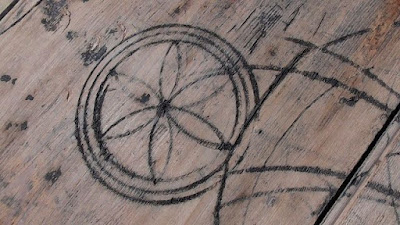Historians and archaeologists believe other techniques were used as well. For example, a cat skeleton and a pot were found buried under the entrance of a historic tavern in Charlestown, Massachusetts. The cat was killed with a single blow to the skull. Animal burials inside walls or under foundations are also commonly found in England, and it's believed the animals were buried to somehow deter witches from entering the buildings. Pots (and shoes) are also commonly found buried under or hidden inside walls, and researchers believe they were intended to trap witches.
Unfortunately, no one has found a historic document that explicitly spells this out so it's not clear if that's really the case. Researchers assume these odd burials had a magical purpose but the people who performed them didn't leave any written explanations. Because witches were perceived to be a common threat it seems likely these burials were protective magic. It's likely - but not proven.
The Fall 2019 issue of Historic New England magazine had an interesting article about daisy wheels, another likely form of defensive magic. "Magic Markings" by Michael J. Emmons, Jr. examines a type of distinctive circular marking that is found many older New England buildings. They look like this:
 |
| From Spade and the Grave |
You can see why they're called daisy wheels. Emmons notes that one of these markings is found in a Portsmouth, New Hampshire house built in 1664, and that they are found in many other old buildings in New England and along the East Coast:
I have encountered dozens of sites featuring these symbols. They are found on walls, doors, fireplace lintels, stairs, attic beams, and even floorboards, and they probably exist in hundreds of early American houses. Apparently created (most of the time) with compasses or carpenters' dividers, the symbols typically consist of an inscribed outer circle enclosing six pointed "petals" that stretch from the circle's center to its perimeter, thus resembling a flower. ("Magic Markings," Michael J. Emmons, Jr., Historic New England, Fall 2019, pp. 4 - 8.)
Emmons goes on to write that they are thought to be "..'witch marks' or 'hex signs,' protective inscriptions to guard one's house, and family, against misfortune (and perhaps actual witches)." He also lays out some other theories: that they were used by carpenters when designing buildings, or were simply doodles carved into the walls by children. There's no strong proof for those theories either, and currently we just don't know the purpose of the daisy wheels.
 |
| From Country Living |
Personally, I think they probably did have a magical purpose, at least at some point in history. As this site points out, daisy wheels are not limited to North America. The ancient Romans seem to have been the first to carve daisy wheels into buildings, and after they conquered Britain the symbol began to appear there as well. It can be found in many Medieval English churches, often carved near baptismal fonts, and carved into furniture as well. The Puritans brought the practice with them when they colonized New England, and in addition to houses the symbol also appears on some 17th century grave stones. I think there must be a purpose to something that was done for nearly 2,000 years.
But perhaps over time the exact purpose was slowly forgotten until finally the practice finally died out. Americans stopped carving daisy wheels into houses by the middle of the 19th century. Significantly, that's also when most Americans had stopped believing seriously in witches. Witchcraft changed from something to be feared to something quaint and folkloric. Witches became the subject of stories told to scare children, not entities to protect your house from.



